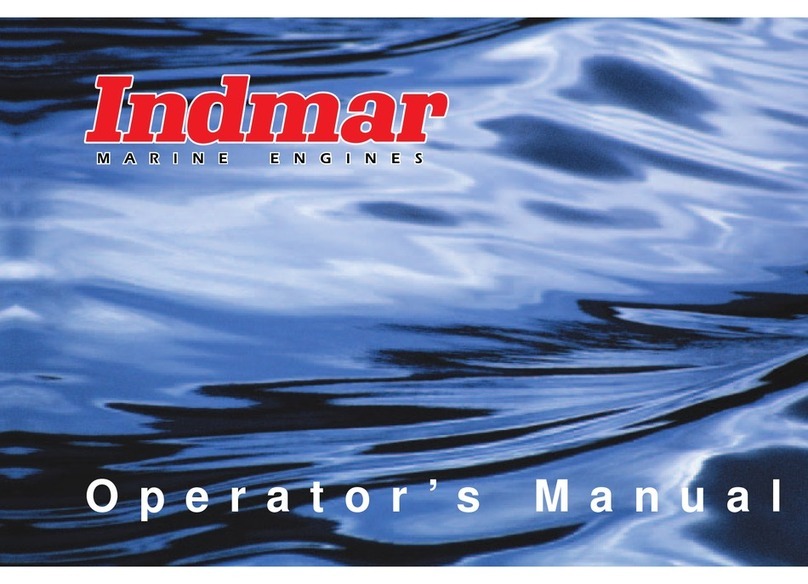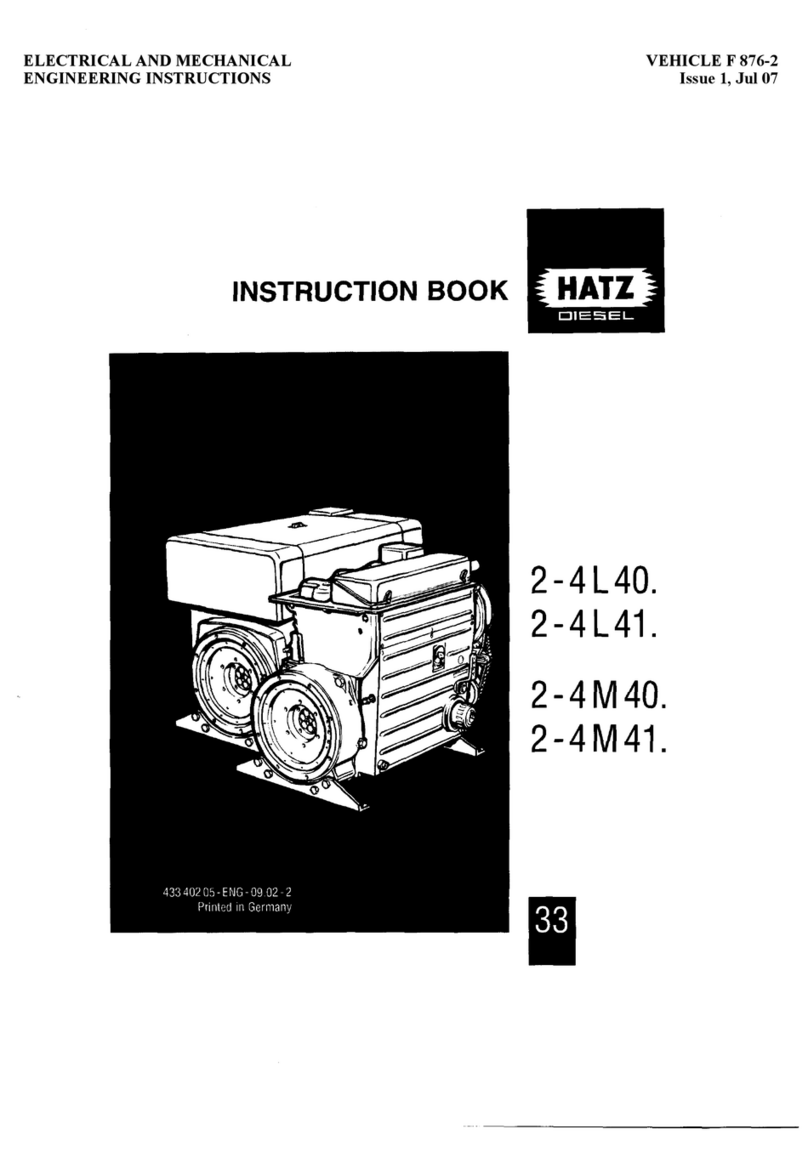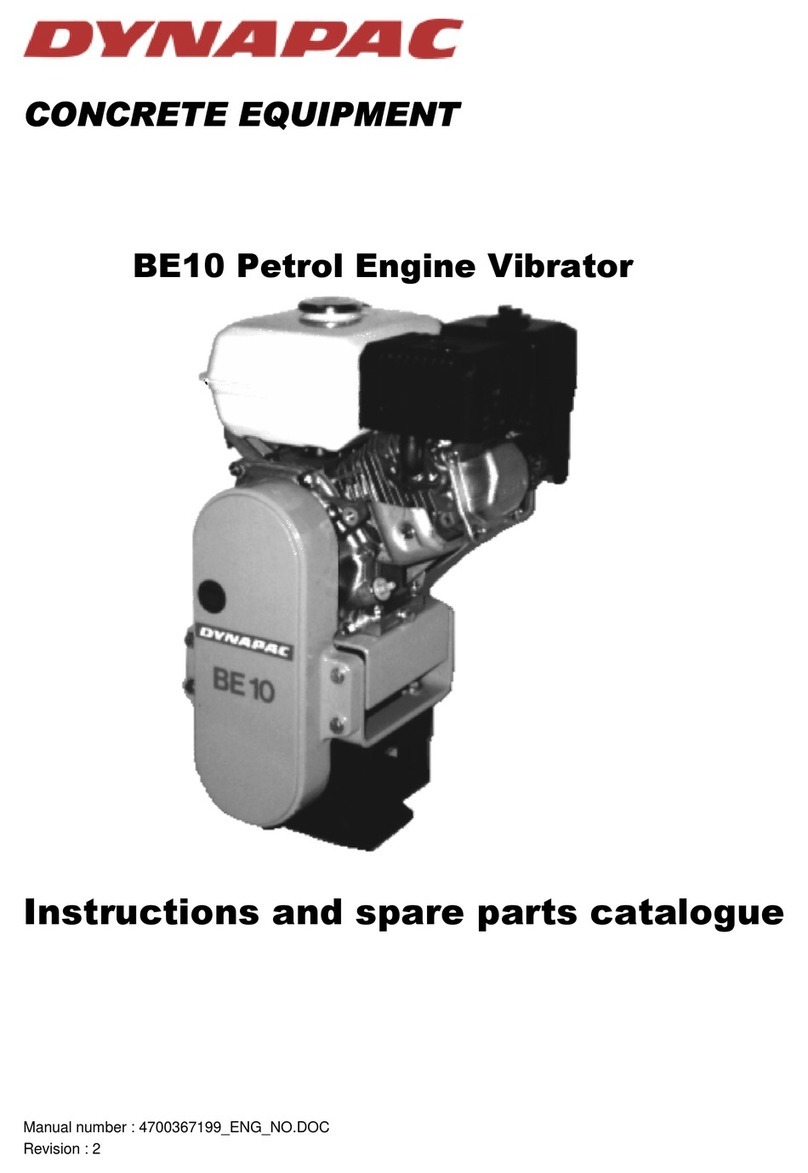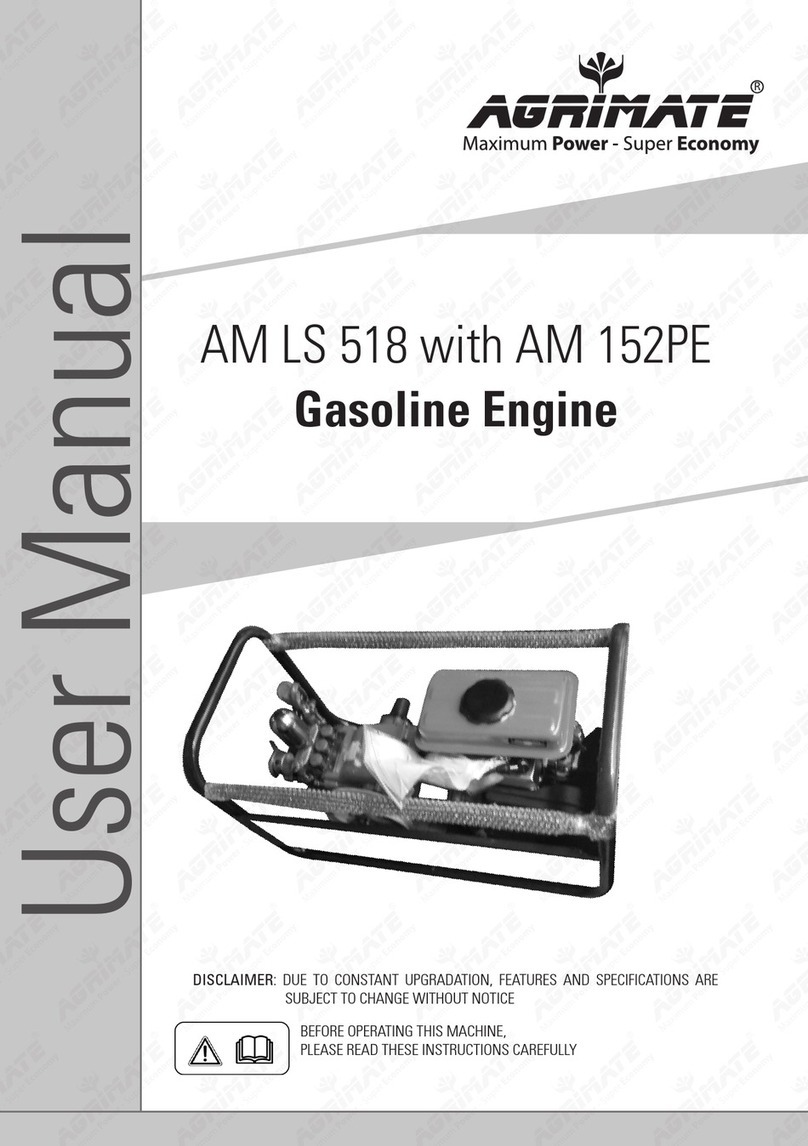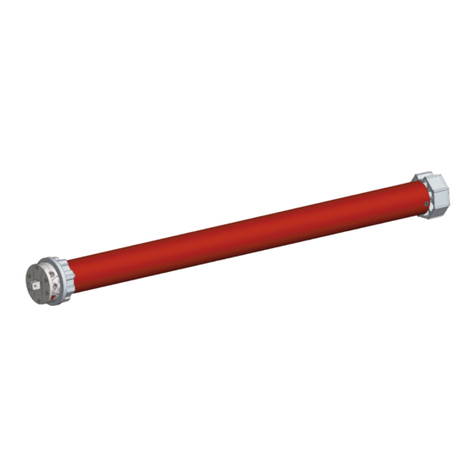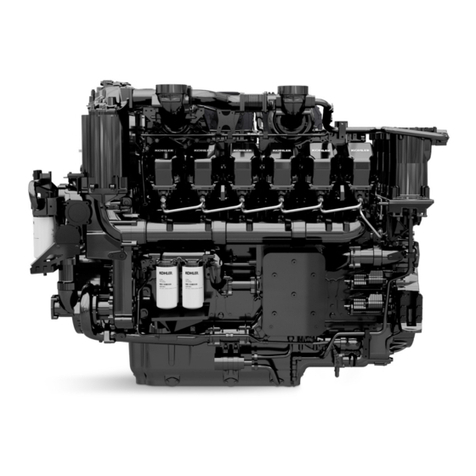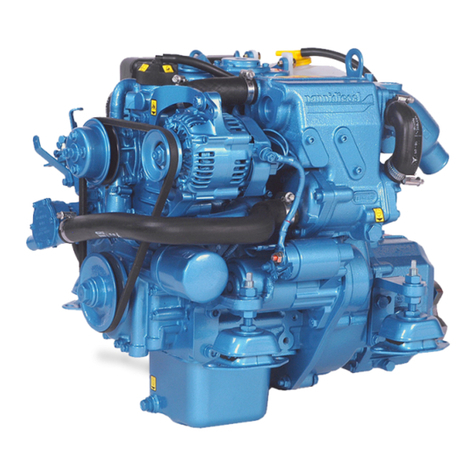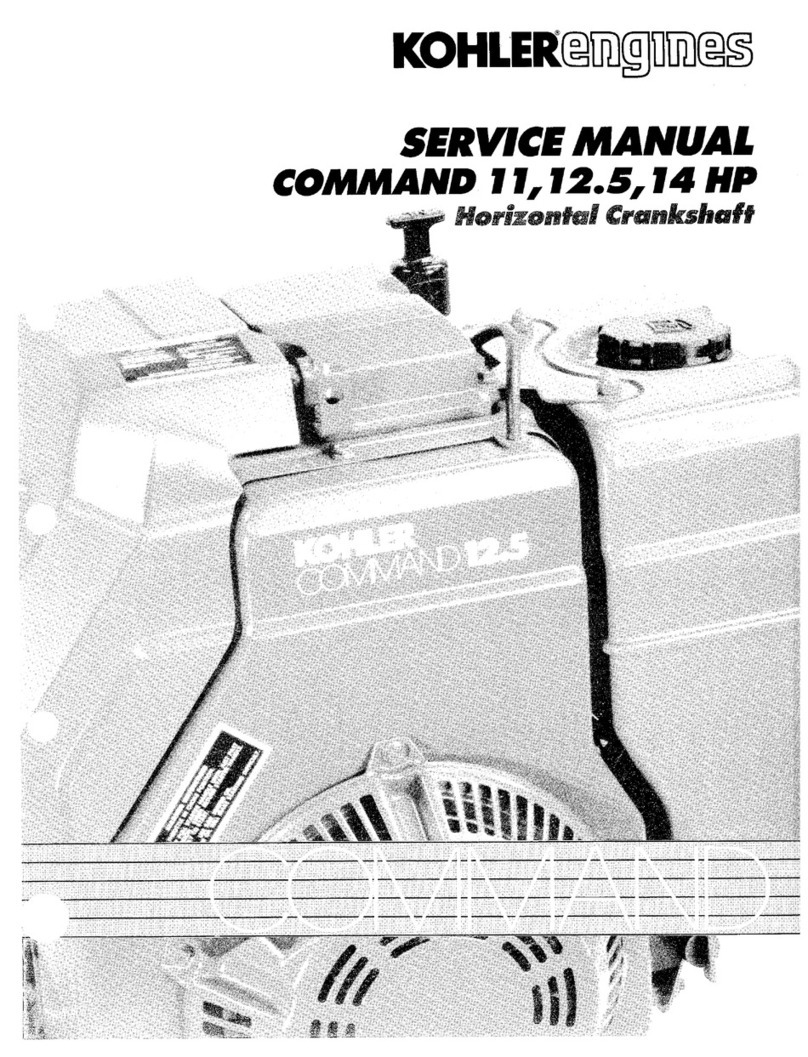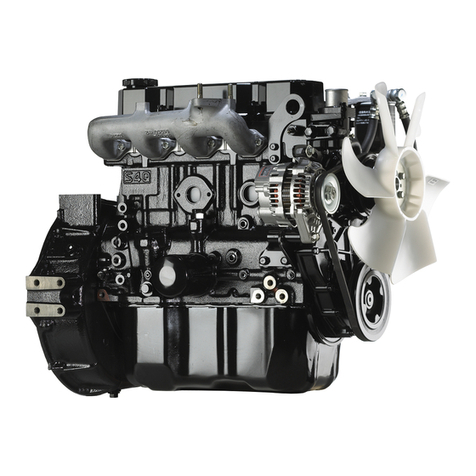Simplex Motion SC Series User manual

Simplex Motion Technical Manual
www.simplexmotion.com Version 2020-05-15 Page 2 of 30
About this document
Simplex Motion AB makes no representations or warranties regarding the content of this document. We reserve the
right to revise this document any time without notice and obligation.
The document describes the general usages of the following motor models: SCxxxx, SMxxxx and SHxxxx (where the x
is the motor models number). For the specific installation, specifications and dimensions of the different motor models,
see the motor specifications document for each motor series.
Index
Simplex Motion Technical Manual.....................................................................................................................................1
1Safety.........................................................................................................................................................................3
1.1 Qualification of personnel .................................................................................................................................3
1.2 Intended Use......................................................................................................................................................3
1.3 Hazard Categories .............................................................................................................................................4
1.4 General safety instructions ................................................................................................................................4
2Communication .........................................................................................................................................................5
2.1 USB communication..........................................................................................................................................5
2.2 Modbus communication ....................................................................................................................................5
2.3 Register map......................................................................................................................................................7
3Device operation......................................................................................................................................................13
3.1 Operating modes..............................................................................................................................................13
3.2 Motor data .......................................................................................................................................................14
3.3 PID controller..................................................................................................................................................14
3.3.1 Feed forward...........................................................................................................................................15
3.3.2 Target value ............................................................................................................................................15
3.4 Ramping control..............................................................................................................................................16
3.5 Sequence control .............................................................................................................................................17
3.6 Homing............................................................................................................................................................18
3.7 Events..............................................................................................................................................................19
3.7.1 Event trigger ...........................................................................................................................................20
3.7.2 Event execution.......................................................................................................................................21
3.8 Recorder ..........................................................................................................................................................22
3.9 External inputs and outputs .............................................................................................................................23
3.9.1 Inputs ......................................................................................................................................................23
3.9.2 Outputs....................................................................................................................................................24
3.9.3 Encoder...................................................................................................................................................25
3.10 Indicator LED..................................................................................................................................................26
4Protection and error handling ..................................................................................................................................27
4.1 List of error codes............................................................................................................................................29
4.2 Hardware reset of registers..............................................................................................................................29
5Power supply considerations and EMC...................................................................................................................30

Simplex Motion Technical Manual
www.simplexmotion.com Version 2020-05-15 Page 3 of 30
1Safety
1.1 Qualification of personnel
Only technicians who are familiar with and understand the contents of this manual and the other relevant documentation
are authorized to work on and with this drive system. The technicians must be able to detect potential dangers that may
be caused by setting parameters, changing parameter values, creating and changing events and generally by the
operation of mechanical, electrical and electronic equipment. The technicians must have sufficient technical training,
knowledge and experience to recognize and avoid dangers. The technicians must be familiar with the relevant
standards, regulations and safety regulations that must be observed when working on the drive system (etc. EMC
Directive, Low Voltage directive and Machinery Directive). If the system is used outside the EU, international, national
and regional directives must be observed.
1.2 Intended Use
The integrated servomotors systems described here are products for general use that conform to the state of the art in
technology and are designed to prevent any dangers. However, drives and drive controllers that are not specifically
designed for safety functions are not approved for applications where the functioning of the drive could endanger
persons. The possibility of unexpected or unbraked movements can never be totally excluded without additional safety
equipment.
For this reason, personnel must never be in the danger zone of the servomotors unless additional suitable safety
equipment prevents any personal danger. This applies to operation of the machine during production and also to all
service and maintenance work on servomotors and the machine. The machine design must ensure personal safety.
Suitable measures for prevention of property damage are also required.
In all cases the applicable safety regulations and the specified operating conditions, such as environmental conditions
and specified technical data, must be observed.
The servomotor system must not be commissioned and operated until completion of installation in accordance with the
EMC regulations and the specifications in this manual. To prevent personal injury and damage to property damaged
servomotors systems must not be installed or operated until this is done.
Changes and modifications of the servomotor systems are not permitted and if made no warranty and liability will be
accepted.
The drive systems must not be operated in an environment subject to explosion hazard.

Simplex Motion Technical Manual
www.simplexmotion.com Version 2020-05-15 Page 4 of 30
1.3 Hazard Categories
Safety notes and general information are indicated by hazard messages in the manual. In addition there are symbols and
instructions affixed to the product that warn of possible hazards and help to operate the product safely. Depending on
the seriousness of the hazard, the messages are divided into three hazard categories.
⚠DANGER
DANGER indicates an imminently hazardous situation, which,
if not avoided, will result in death, serious injury, or equipment
damage.
⚠WARNING
WARNING indicates a potentially hazardous situation, which, if
not avoided, can result in death, serious injury, or equipment
damage
⚠CAUTION
CAUTION indicates a potentially hazardous situation, which, if
not avoided, can result in injury or equipment damage.
1.4 General safety instructions
⚠DANGER
EXPOSED SIGNALS
Hazardous voltage levels may be present if using an open
frame power supply to power the product.
Failure to follow these instructions will result in death or
serious injury.
⚠WARNING
If connecting the motor to the machine, build an external
emergency stop circuit that immediately stops operation and shuts
down power in an emergency.
ACCESS TO MOVING PART
Always ensure that no personnel can access the motor before
operation as it has accessible moving parts.
LOSS OF CONTROL
•The system manufacturer must take the potential error
possibilities of the signals and the critical functions into
account to ensure a safe status during and after errors.
Some examples are: emergency stop, final position
limitation, power failure and restart.
•The assessment of error possibilities must also include
unexpected delays and the failure of signals or
functions.
•Suitable redundant control paths must be in place for
dangerous functions.
•Check that measures taken are effective.
HEAT
The motor will become hot during operation, so do not touch the
motor with bare hands. Failure to observe this caution may result
in burns.
MODIFICATIONS
Do not attempt to disassemble, repair, or modify the product.
Do not change any wiring while power is being supplied.
Failure to follow these instructions can result in death or
serious injury
⚠CAUTION
FAST CHANGES IN MOVMENT
Always attach the motor to a fixed structure before use. Large
torques can be generated if target values is changed. The self-
weight of the motor is then not enough to hold it stable.
HOT PLUGGING!
Do not connect or disconnect power, logic, or communication
while the device is in a powered state. Remove DC power by
powering down at the AC side of the DC power supply.
ENVIROMENT
•Install the servomotor only in environments that meet
the requirements for its protection class.
•Do not step on or place a heavy object on the motor.
Failure to observe this caution may result in injury.
•Be sure to prevent any foreign objects from entering the
product. Failure to observe this caution may result in
malfunction or fire
CABLES
Do not damage the cables or subject them to excessive stress such
as bending or stretching. Do not place heavy objects on the cables
or the cables between other objects where they might be pinched.
Check the wiring to be sure it has been performed correctly.
Connectors and pin layouts are sometimes different for different
models. Always confirm the pin layouts in technical documents for
your model before operation.
Failure to follow these instructions can result in equipment
damage.

Simplex Motion Technical Manual
www.simplexmotion.com Version 2020-05-15 Page 5 of 30
2Communication
The following part describes means of communication to the unit.
2.1 USB communication
(Note; SC-Serie motors do not have an USB interface)
The hardware that have a USB interface, is using the USB type B mini connector type. The interface has full speed
(12Mbit/s) and utilized the USB HID protocol (this does not require a custom driver when connecting the device to a
PC computer since the operating system provides default support for HID devices).
The device is partly powered by the USB connection; It is possible to communicate with the device and perform
configuration without additional power supply. But to start the motor the external power supply is necessary.
If several Simplex Motion devices are connected to the same PC computer, via a USB hub for example, they are
separated with unique addresses. This address is the same used for RS485 Modbus communication, and is set in register
<Address>.
Please note that the USB interface is not very robust for use in harsh environments and high levels of electrical noise.
It is very important that the USB bus and the motor power supply share the same ground potential, as the USB interface
is not isolated. The USB cable length is limited to 5 meters. For applications that require long cables and harsh
environments the Modbus interface is recommended.
The SimplexMotionTool PC software supports use of the USB interface for configuration and testing of the device.
2.2 Modbus communication
The RS485 Modbus RTU interface is a half duplex master-slave protocol. Up to 32 devices can be connected on the
same RS485 lines so that one single master can control up to 31 drive devices. Each device has a unique address
1…126. The default setting is address 1, but it is easily changed by writing to register <Address>.
Modbus ASCII mode is not supported at the moment, as it is less efficient.
Baud rate and parity settings are available through the <ModbusControl> register. The Modbus communication is
completely reset when this register is written. Default settings are 57600 baud and even parity.
All registers accessed through the Modbus protocol have 16 bits, but can be both unsigned and signed. Those registers
that have 32 bits datatypes need dual reads or writes to be accessed. The most significant 16 bits are at the even register
address, while the least significant 16 bits are at the odd address.
The following Modbus function codes are supported:
Value
Description
03
Read holding registers
06
Write single register
08
Diagnostics
16
Write multiple registers
For further information on the Modbus standard please consult www.modbus.org
When using a PC computer for control, there are a number of low cost USB-RS485 converters available on the market.
To allow further flexibility the interface also supports RS232 communication as it is quite common. But the signaling
voltages are limited to 0/3.3V and do not support the RS232 standard +/-3..12V signaling. This is sometimes called
RS232 TTL. However in most cases it is possible to connect to standard RS232 ports using a series resistor of 1kOhm
between the master system TX line and the motor unit RX connection. Note that RS232 does not support several slave
devices, thus only one motor can be used at a time. When using RS232 the connections are according to:
Pin
Name
RS232 usage
7
IN7/RS485A
RX (receive). Connect to master system TX (transmit) signal. Use a 1kOhm series
resistor if standard RS232 signal levels are used.
8
IN8/RS485B
TX. (transmit). Connect to master system RX (receive) signal.

Simplex Motion Technical Manual
www.simplexmotion.com Version 2020-05-15 Page 6 of 30
The configuration is done using bits 8..11 in <ModbusControl> according to:
Value
Description
0
Modbus interface disabled. Connections used for digital inputs.
1
RS485 standard (default)
2
RS485 inverted. This is the same as swapping A/B connections.
3
RS232 standard. Signal level is low when idle (0VDC).
4
RS232 inverted. Signal level is high when idle (3.3VDC).
Some additional notes:
oThe RS485 bus signals are denoted A and B. Unfortunately there are systems using either A or B as the positive
signal, and in some cases it can be necessary to swap A and B. This product expects A to be the positive signal and
B to be the negative. Swapping A and B can be used by setting interface type to RS485inverted in the
<ModbusControl> register.
oBus polarization is usually needed to define the bus state when no device is transmitting. This device has an
internal weak polarization that is sufficient for applications where a termination resistor is not used. It is also
possible to enable a strong polarization (should only be enabled on one unit on the bus) for cases when a
termination resistor is used.
oA termination resistor (100-120Ohm) is recommended when using a high baud rate (>57600) and long cables
(>50m).
oUsing the Modbus protocol on some systems shows register numbering with an offset of 1.
oThe RS485/RS232 interface is not isolated, so the ground potential must be the same as used for the power supply.
oIf using a USB to Serial Port and a high baud rate (115200), the latency timer for the COM port might need to be
updated to a lower value then standard settings used by windows (5ms have been tested to work).
The SimplexMotionTool PC software supports use of the Modbus interface for configuration and testing of the device.

Simplex Motion Technical Manual
www.simplexmotion.com Version 2020-05-15 Page 7 of 30
2.3 Register map
The unit is entirely controlled by its registers that can be read and written using the USB interface or the Modbus RTU
protocol.
There are 3 copies of the entire register map:
Register memory
Description
Standard (RAM memory)
At startup the contents in the ‘Store’ register memory is loaded into the ‘Standard’ register map in
RAM memory. During operation it is always the Standard memory map that is used. It is read and
written using the communication facilities. But this memory loses all its contents if the power
supply is removed.
By use of the ‘Store’ mode setting it is possible to write this register map to the ‘Store’ register
memory. This way the unit will wake up after next power on with these register contents.
Store (non volatile FLASH memory)
This memory holds the register contents to use at power on startup. It can be written from the
‘Standard’ register memory by mode ‘Store’, and it can be written to the ‘Standard’ memory by the
mode ‘Reload’.
Factory (non volatile FLASH memory)
This memory holds the factory default register settings. It can’t be written by other means than
upgrading the firmware. The register settings in this memory can be written to ‘Standard’ and
‘Store’ memory by using the ‘Factory’ mode.
Following is a complete register map with all possible settings.
Nr
Type
Name
Description
Range:
1
uns16
VerParameters
Version number for the parameter structure stored internally.
The most significant byte is major revision and the lower is minor.
0..65535
2
uns16
VerFirmware
Version number of the software in the unit.
The most significant byte is major revision and the lower is minor.
0..65535
3
uns16
VerHardware
Version number of the unit hardware.
The most significant byte is major revision and the lower is minor.
0..65535
10-19
string
ModelName
Model name stored as a string.
20 character string stored in 10pcs 16 bit registers.
20-29
string
SerialNumber
The unique serial number of this unit stored as a string.
20 character string stored in 10pcs 16 bit registers.
30-39
string
UserString1
A user defined string.
20 character string stored in 10pcs 16 bit registers.
40-49
string
UserString2
A user defined string.
20 character string stored in 10pcs 16 bit registers.
50
uns16
Address
Unit address used for communication. This address selects correct unit
when there are several units connected to the same host computer (via USB
hub or several units on the same Modbus data bus). When this value is
changed it does not take effect until a reset operation has been performed
(setting <Mode> register to 1).
1..126
51
uns16
Identification
Used for secure identification of SimplexMotion units
0..65535
52
uns16
ModbusControl
Sets bauderate and parity settings of the Modbus RTU interface. The
interface is directly reinitialized with the new settings when this register is
written.
Bits
Description
0..3
Baude rate setting:
0 = 4800
1 = 9600 (Modbus default)
2 = 19200 (Modbus required support)
3 = 38400
4 = 57600 (SimplexMotion default)
5 = 115200
4..5
Parity settings
0 = Even parity bit (Modbus standard, Default)
1 = Odd parity bit
2 = No parity bit
8..11
Interface type
0 = Interface disabled
1 = RS485 standard (default)
2 = RS485 inverted
3 = RS232 standard (idle = low)
4 = RS232 inverted (idle = high)
12..15
Extra settings
0 = Strong polarization disabled (default)
1 = Strong polarization enabled (useful with bus
termination)
0..65535

Simplex Motion Technical Manual
www.simplexmotion.com Version 2020-05-15 Page 8 of 30
100
uns16
Supply
Measured supply voltage. Unit is 0.01V.
Depends on
motor model
101
uns16
TempElectronics
Measured temperature of the electronics. Unit is 0.01°C
0..12500
102
uns16
TempMotor
Estimated temperature of the motor winding. Unit is 0.01°C
0..12500
120
uns16
SpreadSpectrum
Control of the spread spectrum feature, used to minimize conducted
switching noise on the power supply lines. This is accomplished by
continuously varying the switching frequency.
Value
Description
0
Turned off
1
Frequency variation +/-1.25%
2
Frequency variation +/-2.5%
3
Frequency variation +/-5%
4
Frequency variation +/-10%, Default setting
5
Frequency variation +/-20%
0..3
121
uns16
SpeedFilter
Control of motor speed measurement filter. 0 = no filtering. 4 = normal
filtering. Increasing value is equal to more filtering.
0..15
140
uns16
InputPolarity
The 8 lower bits control input polarity on the inputs IN1-IN7. When set to 0
the corresponding input is active high, while it is active low if set to 1.
0..255
141
uns16
InputThreshold
Threshold level for low/high for the inputs IN5-8. The 16bit value
represents the range 0V to max V. Depending on what model is used, the
max V differs, se motor specification for exact value. A typical setting at
1.0V is the value 13107 for a +5V system.
0..65535
145
uns16
Input
8 bits hold states for digital inputs IN1..8, IN1 in least significant bit. 1 =
active input.
0..255
150-153
uns16
OutputControl[4]
This register controls the mode of a digital output, allowing simple, pulse,
PWM or RC servo pulse output. See section 3.9.2.
0..65535
160-163
uns16
Output[4]
The 4 output values. These are interpreted differently depending on the
output modes set in the respective OutputControl register.
0..65535
170-173
uns16
Analog[4]
Values from analog inputs AIN1..4. The values are full 16 bits that
represent 0 to Max voltage on inputs. Depending on what model is used, the
max V differs, se motor specification for exact value.
Nr
Description
170
AIN1
171
AIN2
172
AIN3
173
AIN4
0..65535
180
uns16
EncoderControl
Controls function of quadrature encoder inputs.
Bits
Description
0..3
Encoder mode
0 = disabled
1 = quadrature encoder input
2 = step/direction input interface
8 = quadrature encoder output (Applicable on SM-
Series and SH-Series. Not applicable to SC-Series)
4..7
Encoder filter
Sets encoder signal filtering 0..7. Default is 4.
8
Invert direction if set to 1
9
Enable pull up resistor if set to 1. There is a weak pull
down resistor when set to 0 (default).
Encoder filter values:
Value
Max pulse frequency
0
10 MHz
1
5 MHz
2
2.5 MHz
3
1.25 MHz
4
625 kHz
5
312 kHz
6
156 kHz
7
78 kHz
0..65535
184/185
int32
Encoder
Value from quadrature encoder interface. Counts 4 * pulse frequency from
encoder when using the quadrature encoder mode. In the step/direction
mode this register holds the pulse count.
-2147483648 ..
2147483647
200/201
int32
MotorPosition
Current motor position. 4096 positions per revolution.
-2147483648 ..
2147483647

Simplex Motion Technical Manual
www.simplexmotion.com Version 2020-05-15 Page 9 of 30
202
int16
MotorSpeed
Measured motor speed. Unit is positions/second / 16.
Value in unit RPM = 60 * MotorSpeed / 256.
-25600..25600
203
int16
MotorTorque
Measured motor torque. Unit is 1mNm.
Depends on
motor model
204
int16
MotorTorqueMax
Setting of torque limit value. Unit is 1mNm.
Depends on
motor model
205
int16
MotorTorqueStop
Maximum torque to use for quickstop of motor in case of error.
Depends on
motor model
206
int16
MotorVd
Motor flux voltage. Only for debugging purposes
-32768..32767
207
int16
MotorVq
Motor torque generating voltage. Only for debugging purposes.
-32768..32767
208
uns16
MotorAngle
Motor commutation angle within electrical turn. Only for debugging
purposes.
0..65535
222
int16
CurrId
Motor flux current for debugging.
-32768..32767
223
int16
CurrIq
Motor torque current for debugging.
-32768..32767
300
int16
RegKp
Regulator proportional parameter. Normal values 500..2000.
0..10000
301
int16
RegKi
Regulator integrative parameter. Normal values 500..2000.
0..10000
302
int16
RegKd
Regulator derivative parameter. Normal values 500..2000.
0..10000
303
int16
RegLimit
Limit value for regulator integration. Normal values 100..500.
0..65535
304
int16
RegDelay
Controls derivative calculation filtering by setting time delay. Normal
values 2..4
Larger values limit the noise, but introduces some time lag.
0..8
305
int16
RegFriction
Speed feedforward term. Used when friction increases with speed.
Unit is Nm/rpm * 10E-6
0..200
306
int16
RegInertia
Acceleration feedforward term. Used for high inertia loads.
Unit is load inertia, kgm2 * 10E-6
0..1000
307
uns16
RegDeadband
Deadband on regulator input error. Typical values 0..20. Higher values
reduce motor noise when stationary (regulator hunting) but degrades
positioning precision.
0..100
308
int16
RegError
Regulator error, sometimes called following error. The actual difference
between present and target values that are inputs to the regulator. The
resolution is 4 times larger than the actual position difference, so the
maximum value 8192 corresponds to 2048 positions, or one half shaft
revolution.
-8192.. 8192
309
uns16
RegErrorMax
Maximum allowed regulator error. Sets status bit when the error gets
beyond this value. Same unit as the RegError register.
0..65535
310
int16
RegOutput
Regulator output (Torque request). Value is relative to the model maximum
torque. Useful for debugging purposes.
0..65535
350
int16
RampSpeed
Current speed command. Unit is positions/second / 16.
-25600..25600
351
int16
RampSpeedMax
Setting of maximum speed. Unit is positions/second / 16.
0..25600
352
int16
RampAcc
Current acceleration command. Unit is positions/second^2 / 256.
Multiply this value by 3.75 to get the unit RPM/s.
0..20000
353
int16
RampAccMax
Setting of acceleration value. Unit is positions/second^2 / 256.
0..20000
354
int16
RampDecMax
Setting of deceleration value. Unit is positions/second^2 / 256.
0..20000
355
Int16
RampJerk
Not used at the moment. Will later be implemented to control 3rd derivative
of position during ramp control.
400
uns16
Mode
Controls mode of drive, according to:
Value
Name
Description
0
Off
Stop mode, motor is off
1
Reset
Resets all running data and then enters
Off mode.
4
Shutdown
When the driver has been shutdown
because of an error. Motor is off.
5
Quickstop
Motor stopped in a controlled manner,
then turned off.
6
Firmware
Firmware upgrade mode. Causes
control to be passed to a bootloader to
receive new firmware through the USB
connection.
7
Factory
Resets all parameters to factory default
settings.
8
Reload
Reloads parameters from non volatile
memory and then enters Reset mode.
9
Store
Store current registers to non volatile
memory. Then jumps to previous
mode.
10
Pwm
PWM mode, open loop control.
20
Position
Closed loop control of position.
21
PositionRamp
Closed control of position with ramp
control.
32
Speed
Speed control mode. Position is
generated from a set speed and position
regulation is done. This ensures a more
0..201

Simplex Motion Technical Manual
www.simplexmotion.com Version 2020-05-15 Page 10 of 30
precise speed control and a wider speed
range.
33
SpeedRamp
Speed control mode with ramp control.
34
SpeedLow
A special low speed mode for higher
resolution at low speed. The supplied
target is divided by 256 before
generating the actual speed value.
35
SpeedLowRamp
Low speed mode with ramping control.
40
Torque
Control of motor torque.
50
SeqPosRamp
Sequence position control by ramping.
51
SeqPosInterpolate
Sequence position control with
interpolation.
54
SeqPosFinished
Sequence position control finished.
60
Beep
Motor produces sound at 500Hz.
70
Homing
Implements motor homing.
200
DemoOn
Starts demo mode. Uses a
potentiometer connected to IN2 and a
pushbutton connected to IN1.
201
DemoOff
Stops demo mode.
401
uns16
ModeStartup
Set the value of <Mode> at power on. Allows automatic start at power on.
0..201
410
uns16
Status
Drive status. Each bit has status information according to the table below.
This status word is used for several things, it can trip the driver or start
recording data. The bits are only active while the condition is true.
Bit
Name
Description
0
Fail
Internal error in the driver.
1
Communication
Communication error.
2
Current
Hardware overcurrent protection triggered.
Motor current beyond normal values.
3
Voltage
Input voltage is too high or low.
4
Temperature
Temperature of drive is too high, motor
temp > 120°C or electronics temp > 100°C.
5
Torque
Motor torque limit active.
6
Locked
Locked shaft condition detected.
Torque > 10% of rated, but speed < 1rps.
7
Regulator
The regulator has a large error.
RegError > RegErrorMax register value.
8
Moving
Motor is rotating, Speed > 0.1rps.
9
Reverse
Motor is rotating in reverse direction.
10
Target
Target reached when ramping position
control.
11
Reserved
For future use.
12
InputA
Digital input, specified by the
<StatusInputs> register.
13
InputB
Digital input, specified by the
<StatusInputs> register.
14
User1
For user application, set by event handler.
15
User2
For user application, set by event handler.
0..65535
411
uns16
StatusLatched
A latched version of the <Status> register. The corresponding bit in this
register is set when it is set in the <Status> register, and then kept set until it
is overwritten by the user.
0..65535
412
uns16
StatusInputs
This register defines two digital inputs that are available in the status
register as InputA and InputB. This is useful for Limit switches that should
cause a driver shutdown. It is also possible to filter these inputs from noise.
Bits
Description
0..3
Input number to use for InputA
4..7
Input number to use for InputB
8..15
Filter value. 0 = no filtering. Increasing values causes
more filtering and larger delay.
0..65535
413
uns16
MaskQuickstop
Mask to select status bits to cause driver quickstop. A one in a bit enables
the corresponding status bit as a trigger for quickstop. A quickstop event
causes the motor to stop in a controlled fashion, usually by applying the
<RampDecMax> setting for deceleration of the motor speed.
0..65535
414
uns16
MaskShutdown
Mask to select status bits to cause a driver shutdown. A one in a bit enables
the corresponding status bit as a trigger for shutdown. A shutdown event
disconnects the motor from the driver immediately, causing the motor to run
freely from its inertia to a stop.
0..65535

Simplex Motion Technical Manual
www.simplexmotion.com Version 2020-05-15 Page 11 of 30
415
uns16
Error
This register holds the latest generated error code. See 4.1 for error codes.
0..65535
420/421
uns32
Time
Tracks time as 2000 counts per second. Wraps around after about 12 days.
This register can also be written.
0 .. 4294967295
450/451
int32
TargetInput
Target value for regulator. Written here when <TargetSelect> = Register.
-2147483648 ..
2147483647
452
uns16
TargetSelect
Sets the target source according to:
Value
Name
Description
0
Register
Target is set by a register content. Written to
register <TargetInput>.
1
Analog 1
Analog value from AIN1 is used as target.
Value 0..65535
2
Analog 2
Analog value from AIN2 is used as target.
3
Analog 3
Analog value from AIN3 is used as target.
4
Analog 4
Analog value from AIN4 is used as target.
5
Encoder
Encoder interface is used for target values. The
encoder can be set for quadrature encoder
input or Step/Dir interface for step motor
emulation. The target value is taken from the
<Encoder> register.
6
Pulse
A digital input pulse length is used to set target
values. Compatible with RC servo pulses.
Not yet implemented.
0..6
453
int16
TargetMul
Value to multiply with input target value before used by the regulator.
-32768 .. 32767
454
int16
TargetDiv
Value to divide the input target with before it is used by the regulator.
-32768 .. 32767
455
int16
TargetOffset
Value to add to the input target before it is used by the regulator. The Offset
is applied after <TargetMul> and <TargetDiv>.
-32768 .. 32767
456/457
int32
TargetMin
Minimum value for target value
-2147483648 ..
2147483647
458/459
int32
TargetMax
Maximum value for target value
-2147483648 ..
2147483647
460
int16
TargetHysteresis
Hysteresis value to remove noise from target values. This is typically useful
when the target source is an analog input. Applied after Mul/Div/Offset.
Typical values 0..1000.
0..65535
461
uns16
TargetFilter
Allows filtering of target values to reduce noise and limit rate of change.
0 = no filtering, increasing values allows more filtering. Typical values 0..7.
0..16
462/463
int32
TargetPresent
The current target value as it is sent to the regulator. Useful for debugging.
-2147483648 ..
2147483647
480-483
uns16
HomeSequence[4]
Sequence definition for homing sequence. 4 individual sequence steps.
The homing features are used to find a position reference at system startup.
See more in section 3.6.
0..65535
490
int16
HomeOffset
Position value to set at homing point
-32768..32767
491
uns16
HomeSpeed
Reference speed to use for homing. Unit is positions/second / 16.
0..25600
492
uns16
HomeAcc
Homing acceleration. Unit is positions/second^2 / 256.
0..20000
493
uns16
HomeTorque
Torque limit to use by hard stop homing. Unit is mNm.
0..2000
494
uns16
HomeDoneMode
Mode to switch to when homing sequence is finished. This value is then
written to register 400.
0..201
495
int16
HomeChange
The amount of position change after a completed homing. Useful for
debugging and basically shows how much repetitive homings deviate.
-32768..32767
500
uns16
SeqControl
Not currently in use. Use register 400 <Mode> to use Seq function. See
section 3.5.
501
uns16
SeqIndex
Current index into the table of positions and time values. Can have values
from 0 to 15. During sequence control this register automatically increments
for each processed table entry. See section 3.5.
0..15
510-540
int32
SeqTarget[16]
Target values of the table. Unit is 1/4096 revolution. See section 3.5.
-2147483648 ..
2147483647
570-585
uns16
SeqTime[16]
Time values of the table. Unit is milliseconds.
0..3999
600
uns16
ApplControl
Control for custom application code loaded into firmware in the device.
0..65535
601
uns16
ApplStatus
Status information from custom application code loaded into the firmware.
0..65535
602
uns16
ApplRuntime
Runtime indication for custom application code. Indicates the percent of
available runtime that is used up by the application code.
0..100
603
uns16
ApplVersion
Version of the custom application code.
The most significant byte is major revision and the lower is minor.
0..65535
620-627
uns16
ApplData
8 registers of general use for the custom application.
0..65535
640-647
uns16
Debug
8 registers used for debugging of the custom application.
0..65535
680-699
uns16
EventControl[20]
Control register for event.
Events are used to cause simple actions to happen from trigger conditions.
For example to set a certain register value when a digital input is activated
from a pushbutton, or activate an output when a register value is above a
certain threshold.
0..65535

Simplex Motion Technical Manual
www.simplexmotion.com Version 2020-05-15 Page 12 of 30
Bits
Description
0..3
Trigger operation
Used to determine if trigger condition is met.
4..7
Trigger filter
Allows filtering of trigger condition.
8..11
Trigger type
0 = Active, 1 = Edge, 2 = Repeat.
12..15
Data operation
Used to manipulate register when event is executed.
See section 3.7 for more information.
700-719
uns16
EventTrgReg[20]
Trigger register number.
0..65535
720-739
uns16
EventTrgData[20]
Trigger data value. 16-bit value to use with trigger register and operator.
0..65535
740-759
uns16
EventSrcReg[20]
Source register number.
0..65535
760-779
uns16
EventSrcData[20]
Source data value. 16-bit value to use with source register and operator.
0..65535
780-799
uns16
EventDstReg[20]
Destination register to write event result to.
0..65535
900
uns16
RecState
State of the recorder. The recorder is used to store measurements in a rapid
pace for debugging and inspection of dynamic behavior. There is space for
500 measurements of 4 channels, each being 16 bits wide.
Value
Name
Description
0
Idle
Recorder in idle, not used.
1
Continuous
Recording continuously
2
Single
Perform one complete recording of 500
values.
3
Trigger
Trigger enabled, recording started when
trigger condition met.
0..3
901
uns16
RecTrigger
Trigger word. This word is used as a mask with the status register. When an
active status bit corresponding to an active <RecTrigger> bit appears the
trigger condition is met.
0..65535
902
uns16
RecPeriod
Sets the recording speed as number of regulator cycles between recordings.
Setting this value to 0 provides the fastest possible recording speed, taking
all 500 measurements in exactly 0.25s.
0..65535
903
uns16
RecPreceding
Sets the number of samples to appear before trigger. This feature makes it
possible to measure just prior to trigger condition.
0..1000
904
uns16
RecOffset
Offset position into data for start. Since the data area is used as a circular
buffer that runs continuously, the first data point is not always in the first
memory position. Instead the first data is at the <RecOffset> position.
0..999
905-908
uns16
RecRegister[4]
Register numbers for the 4 channels to record.
0..4999
1000-
1499
int16
RecData1[500]
Data for recording channel 1. Data can be uns16 or int16 depending on the
source register. 500 values in consecutive register addresses.
0..65535
2000-
2499
int16
RecData2[500]
Data for recording channel 1. Data can be uns16 or int16 depending on the
source register. 500 values in consecutive register addresses.
0..65535
3000-
3499
int16
RecData3[500]
Data for recording channel 1. Data can be uns16 or int16 depending on the
source register. 500 values in consecutive register addresses.
0..65535
4000-
4499
int16
RecData4[500]
Data for recording channel 1. Data can be uns16 or int16 depending on the
source register. 500 values in consecutive register addresses.
0..65535

Simplex Motion Technical Manual
www.simplexmotion.com Version 2020-05-15 Page 13 of 30
3Device operation
This chapter will explain the operation of the unit and how it is controlled through the registers.
3.1 Operating modes
The <Mode> register controls the overall behavior of the motor unit. The following table describes the different modes:
Name:
Value:
Description:
Off
0
Stop mode, motor is off.
Reset
1
Resets drive
All running data is reset, such as current position. Automatically changes <Mode> to Off mode.
Shutdown
4
The driver is shut down because of an error. Motor is off.
This happens if any status bits enabled by the <MaskShutdown> becomes active. This is a feature to
shutdown the motor in case of events such as high temperature, internal error etc.
Quickstop
5
Motor stopped in a controlled manner, then turned off. A quickstop event causes the motor to stop in a
controlled fashion, usually by applying the <RampDecMax> setting for deceleration of the motor speed. This
happens if a status bit enabled by the corresponding bit in the <MaskQuickstop> becomes active.
Firmware
6
Firmware upgrade mode. Causes control to be passed to a bootloader to receive new firmware through the
USB connection. A special PC software is needed to download the new firmware.
Factory
7
Resets all parameters to factory default settings. Then sets <Mode> to Reset mode.
Reload
8
Reloads parameters from non volatile memory and resets all running data. This is equivalent to cycling the
powersupply to restart the unit. The default register contents that are loaded decide which is the final mode
setting.
Store
9
Store the current registers to non volatile memory
After the registers has been stored the mode changes automatically to the previous mode.
Pwm
10
PWM mode, open loop control
The <Target> value [-32768..32767] is directly converted to motor voltage, where -32768 is full speed
reverse, 0 is standstill, and 32767 is full speed forwards. There is no regulator involved, and no ramping.
Torque is not limited. This mode is mainly supported for testing and has limited use.
Position
20
Closed loop control of position
This mode uses the PID regulator to perform closed loop regulation of the motor position. Torque limit is
active.
PositionRamp
21
Closed loop control of position with ramp control
Similar to the ‘Position’ mode but does also support ramping control of the position. This means controlled
acceleration and speed according to user settings. This is the preferred mode since it typically limits torque
and supply currents and causes even motions with less vibration.
Speed
32
Speed control mode. Motor position is generated from a set speed and position regulation is done. This
results in a more precise speed control and the ability to control speed down to 0 rpm.
SpeedRamp
33
Speed control mode with ramp control. This is the recommended mode for general speed control
applications.
SpeedLow
34
A special low speed mode for higher resolution at low speed. The supplied target is divided by 256 before
generating the actual speed value.
SpeedLowRamp
35
Low speed mode with ramping control.
Torque
40
Control of motor torque. Has a speed limit feature as well (set maximum speed in the <RampSpeedMax>
register). The required torque (target value) is scaled so that a signed 16 bit value covers the motor maximum
torque range. So the maximum torque value is +/-32767.
Beep
60
Motor produces sound at 500Hz
Target value sets amplitude. Can be used for user communication.
Homing
70
Implements motor homing. Setting this mode starts the homing sequence. Once finished the mode register is
set to the contents in the <HomeDoneMode> register.
DemoOn
200
Starts demo mode. Uses a 10k potentiometer connected to +5V/IN2/GND and a pushbutton connected from
IN1 to GND for user control.
The demo mode uses the potentiometer to set target value, and a pushbutton to change between 4 testmodes.
Each press advances the testmode one step, while pressing for more than 1 second jumps to the first
testmode.
Nr
Testmode
Potentiometer range
1
Speed regulation
Speed from 0 to 5000rpm.
2
Low speed regulation
Speed from 0 to 20rpm.
3
Position regulation
Position from 0 to 8192 (2 turns)
4
Position regulation with ramping
Position from 0 to 65535 (16 turns)
DemoOff
201
Stops demo mode
Changes <Mode> to ‘Reset’ mode after turning the demo mode off.

Simplex Motion Technical Manual
www.simplexmotion.com Version 2020-05-15 Page 14 of 30
3.2 Motor data
Some registers are related to motor data, and here follows a summary of these.
Name
Type
Nr
Description
TempMotor
uns16
102
Estimated temperature of the motor. Unit is 0.01°C
The value is calculated by use of a thermal model of the device. The temperature of the
electronics is directly measured, and since the electronics have a tight thermal coupling to the
device enclosure, and the thermal resistance from motor winding to the enclosure can be
described by a simple relationship to motor speed, it is possible to get reasonably accurate
results this way.
Overtemperature condition is also reflected in a status bit (see 4).
SpeedFilter
uns16
121
Control of motor speed measurement filter. 0 = no filtering. 4 = normal filtering. Values 0..15
are possible. Increasing value is equal to more filtering, which produces a less noisy speed
measurement, but at the same time increases time lag in the measurement.
MotorPosition
int32
200/201
Current motor position. 4096 positions per revolution.
The value is reset to zero at start. It can be changed by the user by writing the register. The value
is reset in the operating mode ‘Reset’.
MotorSpeed
int16
202
Measured motor speed. Unit is positions/second / 16. There are 4096 positions per revolution.
The maximum speed of 6000rpm equals a speed value of 25600. Negative speed values
represent rotation in the negative direction. The measured speed is filtered to minimize noise,
and the filter is configurable by use of register <SpeedFilter>.
MotorTorque
int16
203
Measured motor torque. Unit is mNm. Negative values represent torque in negative rotational
direction.
MotorTorqueMax
int16
204
Setting of torque limit value. Unit is mNm.
Limiting torque to a value that is suitable for the application is recommended. Torque limiting is
always active, independent of operating mode. The same limiting value is used for both braking
and driving, and in both rotational directions.
MotorTorqueStop
int16
205
Setting of torque limit value for motor stopping in quickstop mode. Unit is mNm.
MotorVq
int16
207
Motor voltage value. Possible values are -32768..0 for negative voltage, and 0..32767 for
positive voltage. Mainly used for debugging purposes.
CurrIq
int16
223
Motor current value. Possible values are -32768..0 for negative current, and 0..32767 for
positive current. Mainly used for debugging purposes.
3.3 PID controller
For regulation of motor speed or position there is a PID controller. This controller calculates the error as the difference
between the target value and the present value, and then forms the motor control value as a sum of a proportional,
integral and derivative component of the error.
These 3 components have their own gain parameters that set the controller characteristics.
For general information on PID controllers, see: http://en.wikipedia.org/wiki/PID_controller
The PID regulator used here also compensates for power supply variation, which means that the same performance of
the motor can be expected across the entire power supply range. An exception to this is when the unit is used at high
rotational speeds, as the top speed is limited by the supply voltage.
Summary of regulator parameters:
Name
Type
Nr
Description
RegKp
int16
300
Regulator proportional parameter. Normal values 100..1000.
This parameter is usually the most important contributor to controller performance, as it sets the
‘stiffness’ of the motor (resistance to errors). Large values can result in significant overshoot and
instability. Low values causes larger positioning errors.
RegKi
int16
301
Regulator integral parameter. Normal values 100..1000.
The integral part is responsible for eliminating the residual steady state error of the controller. Large
values will affect stability. Low values can cause a stationary error.
RegKd
int16
302
Regulator derivative parameter. Normal values 100..1000.
The derivative component slows the transient response and thus helps keep the controller stable and
minimizes controller overshoot. This controller part has the largest amount of noise, using the
<RegDelay> parameter can minimize this issue. Noise in the controller can show up as audible noise
from the motor. Usually it is best to start tuning the PID regulator with this value set to 0.
RegLimit
int16
303
Limit value for regulator integration. Normal values 100..500.
When a large error is present for some time the integral part of the controller can become very large and
this can cause extreme overshoots of the controller. Therefore there is a limit to the integral of the error,
adjustable by this register.
RegDelay
int16
304
Controls derivative calculation filtering, which also produces a delay. Normal values 2..4, range 0..8.

Simplex Motion Technical Manual
www.simplexmotion.com Version 2020-05-15 Page 15 of 30
Large values will decrease the noise in the derivative component of the regulator, but at the same time
increase time lag.
RegFriction
int16
305
Speed feedforward term. Used when friction increases with speed.
Setting this parameter correctly greatly reliefs the PID controller and thus decreases the controller error.
Unit is Nm/rpm * 10E-6
RegInertia
int16
306
Acceleration feedforward term. Used for high inertia loads.
Setting this parameter correctly greatly reliefs the PID controller and thus decreases the controller error.
Unit is load inertia, kgm2 * 10E-6
RegDeadband
uns16
307
Dead band on regulator input error. When the motor is stationary in position regulation mode it is
common to hear some audible motor noise. This comes from the constant regulation to stay at the target
position, sometimes called ‘regulator hunting’. If positioning precision can be allowed to degrade
somewhat it is possible to get rid of this noise. By setting a dead band the regulator will not care about
errors less than this dead band value, and thus the regulator will be idle.
Typical values 0..20. 0 = turn off dead band feature.
RegError
int16
308
Regulator error, sometimes called following error.
This value is the calculated controller error. Observing this value lets the user measure the performance
of the motor drive unit. It is a good indicator of controller performance when tuning the regulator
parameters.
The resolution is 4 times larger than the actual position difference, so the maximum value 8192
corresponds to 2048 positions, or one half shaft revolution.
RegErrorMax
uns16
309
Maximum allowed regulator error. Sets status bit ‘Regulator’ when the error gets beyond this value. This
can be used to monitor if the regulator error has been beyond a certain value during a session. Or to shut
down the unit if error gets really large. Same unit as register <RegError>.
RegOutput
int16
310
Regulator output (Torque request). Value is signed 16bits relative to the model maximum torque. Useful
for debugging purposes.
3.3.1 Feed forward
In some cases the motor speed and/or acceleration is known, and this makes it possible to help the PID controller by
introducing feed forward components. One such case is when running ramp controlled moves, where the target
acceleration and speed is continuously calculated. If characteristics of the motor load is known, it is possible to make
use of this information for improved control. There are two feed forward components, one for speed and one for
acceleration.
The speed feed forward term is used to compensate for loads where the torque increases with rotational speed. The
register used is <RegFriction>, and the unit is Nm/rpm * 10E-6. This value is difficult to calculate, so usually
experimenting will be necessary. A good start value can be 100.
The acceleration feed forward term compensates for the load inertia, as the torque needs to be increased to change the
rotational speed. This is especially important in high inertia applications, such as linear positioning devices with heavy
loads. This value can usually be calculated, but experimenting can also be used to find an appropriate value. The
register used is <RegInertia> and the unit is load inertia (as seen on the motor shaft) kgm2 * 10E-6.
To test and trim the feed forward components one can briefly disable the regulator by setting the PID controller
parameters (RegKp, RegKi, RegKd) to zero, and apply a ramp controlled position move. By observing the regulator
error across the movement (by using the recorder, see 3.8) one can change the parameters until the error is minimized.
There is a feature in the SimplexMotionTool PC software to aid in this tuning.
3.3.2 Target value
The target value is the PID controller setpoint value. It can be obtained from several different sources, configured by the
register <TargetSelect>:
Name
Value
Description
Register
0
Target is set by a register content. Written to register <TargetInput>.
This setting is typically used when the device is continuously controlled through the communication bus.
AIN1
1
Analog value from IN1 is used as target. The analog value has the range 0..65535.
This makes setting of the target value by a potentiometer possible. Connect the potentiometer as a resistive divider
between the supplied +3.3V or +5V (depending on model) and GND. Any other voltage source providing a 0..+3.3V or
0..+5V voltage can be used.
AIN2
2
Analog value from IN2 is used as target.
AIN3
3
Analog value from IN3 is used as target.
AIN4
4
Analog value from IN4 is used as target.
Encoder
5
The encoder input is used as target.
The encoder output is available in register <Encoder>, and this value is used as target value. The encoder interface can
be configured both for quadrature encoder input and for step/direction signal interface.
This feature makes it easy to track another motor that supplies an encoder output, or to emulate a step motor interface.
Pulse
6
A digital input pulse length is used to set target values. Compatible with 1-2ms RC servo pulses.
Not implemented yet.

Simplex Motion Technical Manual
www.simplexmotion.com Version 2020-05-15 Page 16 of 30
A few more settings are available for the handling of target values. Scaling and offsetting of target values is of great use
when the target source is some external input such as an analog input. The registers <TargetMul> and <TargetDiv> is
used for scaling, and the <TargetOffset> for offsetting. The offset is applied after the multiplication and division
operations.
It is possible to limit target values by min and max bounds. This is done by the <TargetMin>/<TargetMax> registers.
There are also features to deal with noise on the input target values. This can be done in two ways, by hysteresis or by
filtering. The <TargetHysteresis> register allows the target value to change by small amounts, less than the register
value, before the actual used target changes. Setting the register to zero eliminates this feature. The <TargetFilter>
register allows filtering instead. A value of zero disables the filter, while an increasing value adds more filtering.
For debugging, the final target value as sent to the PID regulator, can be read from the register <TargetPresent>.
A full summary of target related registers:
Name
Type
Nr
Description
TargetInput
int32
450/451
Target value for regulator. Written here when TargetSelect = Register.
TargetSelect
uns16
452
Sets the target source according to:
Value
Name
Description
0
Register
Target is set by a register content. Written to
register TargetInput.
1
Analog 1
Analog value from AIN1 is used as target.
2
Analog 2
Analog value from AIN2 is used as target.
3
Analog 3
Analog value from AIN3 is used as target.
4
Analog 4
Analog value from AIN4 is used as target.
5
Encoder
Encoder interface is used, enabling both
quadrature encoder input or step/direction
signals.
6
Pulse
A digital input pulse length is used to set target
values. Compatible with RC servo pulses.
TargetMul
uns16
453
Value to multiply with input target value before used by the regulator.
TargetDiv
uns16
454
Value to divide the input target with before it is used by the regulator.
TargetOffset
uns16
455
Value to add to the input target before it is used by the regulator.
TargetMin
int32
456/457
Minimum value for target value
TargetMax
int32
458/459
Maximum value for target value
TargetHysteresis
int16
460
Hysteresis value to remove noise from target values. This is typically useful when the target
source is an analog input. Applied after Mul/Div/Offset. Typical values 0..1000.
TargetFilter
uns16
461
Allows filtering of target values to reduce noise and limit rate of change.
0 = no filtering, increasing values allows more filtering. Typical values 0..7.
TargetPresent
int32
462/463
The current target value as it is sent to the regulator.
3.4 Ramping control
In most applications it is desirable to limit acceleration and speed values to configurable levels. This is accomplished by
ramping control. It is available both for speed control and for position control. The mode setting (see 3.1) determines if
it is being used or not.
Acceleration limits are divided in two registers, one for acceleration and one for deceleration. This is done since
applications with large inertia loads may need to keep low deceleration rates to limit the overvoltage created when the
energy from the mechanical load is transferred to the power supply (the motor acts as a generator).
The following table summarizes the available registers for ramping control:
Name
Type
Nr
Description
RampSpeed
int16
350
Current speed command. Unit is positions/second / 16.
This value changes continuously during acceleration/deceleration to reflect the current target speed. It is
also used to implement the speed feed forward component of the PID regulator.
RampSpeedMax
int16
351
Setting of maximum speed. Unit is positions/second / 16.
This is the speed limit for speed control mode, and the top speed used for position moves in position
control mode.
RampAcc
int16
352
Current acceleration command. Unit is positions/second^2 / 256.
This value reflects the present acceleration. Used by the acceleration feed forward component of the
PID regulator.
RampAccMax
int16
353
Setting of acceleration value. Unit is positions/second^2 / 256.
RampDecMax
int16
354
Setting of deceleration value. Unit is positions/second^2 / 256.

Simplex Motion Technical Manual
www.simplexmotion.com Version 2020-05-15 Page 17 of 30
3.5 Sequence control
To simplify sequence of movements there is a sequence feature. This feature is based on a table of 16 entries with
position and time values. The table resides on registers <SeqTarget0> - <SeqTarget15> and <SeqTime0> -
<SeqTime15>. Position values in <SeqTargetX> registers are standard motor position values (4096 per revolution), and
time values in <SeqTimeX> are in milliseconds. The index of the current table entry is stored in register <SeqIndex>.
When a table entry has been processed (the specified time has passed), the <SeqIndex> register is incremented, and the
next table entry processed. If at the last table entry the index pointer will simply wrap-around to 0 to start over in the
table. If a time value of 0 is encountered, the sequence will be immediately stopped and the <Mode> register will be
changed to reflect this.
This feature can operate in two modes:
Mode
Description
Ramping control sequence
A ramping movement is done to the specified position and the specified time is used for delay until next movement.
The motor typically stands still for a moment before the next move, and the specified time should therefore be
longer than the time needed to perform the ramp move.
For each table entry: A ramp move is started to the specified position, and the delay timer restarted to the specified
time value. When the time has elapsed the next table entry is processed. The sequence is terminated by a time value
of 0 in a table entry, or if the <Mode> register is changed.
Interpolation control
The motor performs interpolation of the target value between tables entries. This mode is for continuous motion
without stops.
For each table entry: A movement is started from the current table entry position towards the next table entry
position, to finish after the time specified in the current table entry. Each such movement will have constant speed.
In future implementation there will be possibilities to also interpolate speed to have constant acceleration.
This mode can be used with a master system continuously writing new values to the table as they are consumed, and
in such a way implement continuous custom motion with the limited bandwidth of the communication to the motor.
By reading the <SeqIndex> the master can tell what table entries has already been consumed and then write new
values to those positions. The table pointer will wrap around from last to first table entry as long as no 0 value in the
time entry has been encountered.
The following <Mode> values are used to control this feature:
<Mode> register value
Description
50
Sequence control of position by ramp control
51
Sequence control of position by interpolation
54
Sequence control of position is finished. When a time value of 0 is
encountered the sequence control is terminated and <Mode> changed to
this value.
The following table summarizes the available registers for sequence control:
Name
Type
Nr
Description
SeqIndex
uns16
501
Current index into the table of positions and time values. Can have values from 0 to 15. During
sequence control this register automatically increments for each processed table entry.
SeqTarget[16]
int32
510-
541
Target values of the table. Unit is 1/4096 revolution.
SeqTime[16]
uns16
570-
585
Time values of the table. Unit is milliseconds.

Simplex Motion Technical Manual
www.simplexmotion.com Version 2020-05-15 Page 18 of 30
3.6 Homing
In many applications the position control is in absolute terms. This requires the system to obtain a position reference at
startup. This procedure is commonly termed ‘homing’ or ‘referencing’ and often operates by slowly moving the motor
in one direction until a home switch is engaged. When the switch is operated the motor position is reset to some known
value. There are a lot of different schemes for the homing sequence though, and therefore a flexible 4-step homing
sequence is supported by the SimplexMotion motor units.
The general homing speed and acceleration is set by the HomeSpeed and HomeAcc registers.
Each of the sequence steps are configured by a 16-bit HomeSequence register.
Bit 15
Bit 14
Bit 13
Bit 12
Bit 11
Bit 10
Bit 9
Bit 8
Bit 7
Bit 6
Bit 5
Bit 4
Bit 3
Bit 2
Bit 1
Bit 0
Relative speed
Filter
Polarity
Direction
Condition source
Each step runs the motor in the direction set by the ‘Direction’bit, until a condition is met.
Direction
Description
0
Positive direction
1
Negative direction
The condition is defined by the ‘Condition source’ according to:
Value
Description
0
None, this step is disabled
1
Torque. If motor torque is above HomingTorque register value, and Polarity is set to 1,
this condition becomes true.
2
Digital input IN1
3
Digital input IN2
4
Digital input IN3
5
Digital input IN4
6
Digital input IN5
7
Digital input IN6
8
Digital input IN7
9
Digital input IN8
10
The sequence runs the motor for the time specified by the ‘Filter’ bits
The ‘Polarity’ bit decides if the condition is met when then input is high or low.
Polarity
Description
0
Condition met when input is low.
1
Condition met when input is high.
There is a filtering feature as well if the condition input is noisy. This works by requiring the condition to be true a
number of times in a sequence. The ‘Filter’ entry can be set to 0-15, which selects a number of regulator cycles
according to the table below.
Setting
Cycles
Time delay
0
No filter
1
2
1ms
2
4
2ms
3
8
4ms
4
16
8ms
5
32
16ms
6
64
32ms
7
128
64ms
8
256
128ms
9
512
256ms
10
1024
512ms
11
2048
1.02s
12
4096
2.05s
13
8192
4.10s
14
16384
8.19s
15
32768
16.4s
To allow different speeds for the homing sequence steps there is also a 4-bit ‘Relative speed’entry. The value 0-15 is
interpreted as relative speed 0-100% of the <HomeSpeed> register value.

Simplex Motion Technical Manual
www.simplexmotion.com Version 2020-05-15 Page 19 of 30
When all of the 4 steps have been completed (those that are not used should be set to 0) the <MotorPosition> register is
reset to the value in the <HomeOffset> register. The difference between the actual <MotorPosition> value at this
instant, and the <HomeOffset> value, is stored in the <HomeChange> register. This value makes it easy to check the
precision of the homing sequence by performing it repeatedly and studying the <HomeChange> register contents.
The <HomeDoneMode> register is used to change the <Mode> register when the homing sequence has completed. This
is useful for example to jump right into position regulation mode after the homing sequence is finished. For standalone
operation it might be useful to store the homing mode in the non volatile memory to make the system automatically
perform homing at power on, and then entering the position regulation mode when homing is completed.
Related to homing are ‘Limit switches’, that are typically used to turn off the driver when the position approaches a
mechanical stop to avoid damage. Support for limit switches works by using any of the digital inputs, and then
specifying this input to be monitored in the status register. This enables ‘Shutdown’ or ‘Quickstop’ modes to be
automatically asserted from activating these inputs. Read more in section 4 about this.
It may also be possible to avoid end switches completely in an application by carefully setting the maximum motor
torque and assuring that there are mechanical stops that can withstand this torque. The homing sequence can use torque
sensing to detect the reference position, and the status bit ‘Torque’ can be used to automatically disable the motor
(‘Shutdown’ or ‘Quickstop’ modes).
The following table summarizes the available registers for homing control:
Name
Type
Nr
HomeSequence[4]
uns16
480-
483
Sequence definition for homing sequence. 4 individual sequence steps.
The homing features are used to find a position reference at system startup.
HomeOffset
int16
490
Position value to set at homing point
HomeSpeed
uns16
491
Reference speed to use for homing. Unit is positions/second / 16.
HomeAcc
uns16
492
Homing acceleration. Unit is positions/second^2 / 256.
HomeTorque
uns16
493
Torque limit to use by hard stop homing. Unit is mNm.
HomeDoneMode
uns16
494
Mode to switch to when homing sequence is finished. It is then written to register 400.
HomeChange
int16
495
The amount of position change after a completed homing. Useful for debugging and basically
shows how much repetitive homings deviate.
3.7 Events
⚠WARNING
EVENTS SAFETY
Improper use of events could disable other function such as
“Shutdown” and “Quickstop” etc. that could lead to a hazardous
situation. Take great care when using events and don’t use them to
disable other safety functions.
Failure to follow these instructions can result in death or
serious injury
To make stand alone operation of the unit possible, a feature called event handling is available. It solves the task of
letting digital inputs, for example connected to pushbuttons, affect registers such as increasing the speed, stopping the
motor etc. Or setting digital outputs based on register contents such as ‘motor position is larger than xxx’.
There are 20 separate and independent events available. Each event is evaluated each regulator cycle at 2kHz.
Events are based on trigger conditions that act on a selected register. When a trigger is activated, another register
manipulation is executed. By manipulating registers it is possible to change the motor operation, set a digital output, or
control any other aspect of the motor unit.

Simplex Motion Technical Manual
www.simplexmotion.com Version 2020-05-15 Page 20 of 30
3.7.1 Event trigger
A trigger condition is met when a register content together with an operator and a data value produces a non zero result.
Any register can be selected by entering the register number in the <EventTrgReg> register. There are 16 operators to
choose from, and the selection is done by setting the 4 bits at bit positions 0..3 in the <EventControl> register. The data
value used is entered in the <EventTrgData> register. The trigger value is calculated as follows, and the trigger becomes
active when this value is nonzero.
Trigger value = <Register> OPERATOR DataValue
The following operators are available:
Value:
Operator:
0
Always true
1
=
Equal
2
!=
Not equal
3
<
Less than
4
>
Greater than
5
or
Bitwise or
6
nor
Bitwise not or
7
and
Bitwise and
8
nand
Bitwise not and
9
xor
Bitwise exclusive or
10
nxor
Bitwise not exclusive or
11
+
Add
12
-
Subtract
13
*
Multiply
14
/
Divide
15
Value
Takes data value directly
The trigger can also be filtered to increase rejection to noise (for example pushbutton debouncing) or to create a time
delay. The filter will require the trigger evaluation to be active a certain number of times in a row before it is interpreted
as activated.
Together with the ‘repeat’ trigger type it also allows the event to be executed at a controlled repetition rate when the
trigger condition is continuously true. This can for example be used to repeatedly increase the position of the motor
when a pushbutton is being held pressed for a long time.
The filter is configured by the 4 bits at bit positions 4..7 in the <EventControl> register according to:
Setting
Evaluations
Time delay
0
No filter
1
2
1ms
2
4
2ms
3
8
4ms
4
16
8ms
5
32
16ms
6
64
32ms
7
128
64ms
8
256
128ms
9
512
256ms
10
1024
512ms
11
2048
1.02s
12
4096
2.05s
13
8192
4.10s
14
16384
8.19s
15
32768
16.4s
The trigger can also have different types of behavior to further expand the flexibility. See the following table for the 3
types of triggers available. The type is configured by setting the bit positions 8..11 of the <EventControl> register.
Setting
Trigger type
Description
0
Active
Event is performed each time the filtered trigger condition is true.
1
Edge
Event is only performed the first time the filtered trigger condition becomes true. The trigger condition
has to become deactivated again before next trigger can occur.
2
Repeat
Event is performed repeatedly while the trigger condition is true, but the filter is reset each time so that
the filter creates a time delay between event executions.
This manual suits for next models
2
Table of contents
Popular Engine manuals by other brands
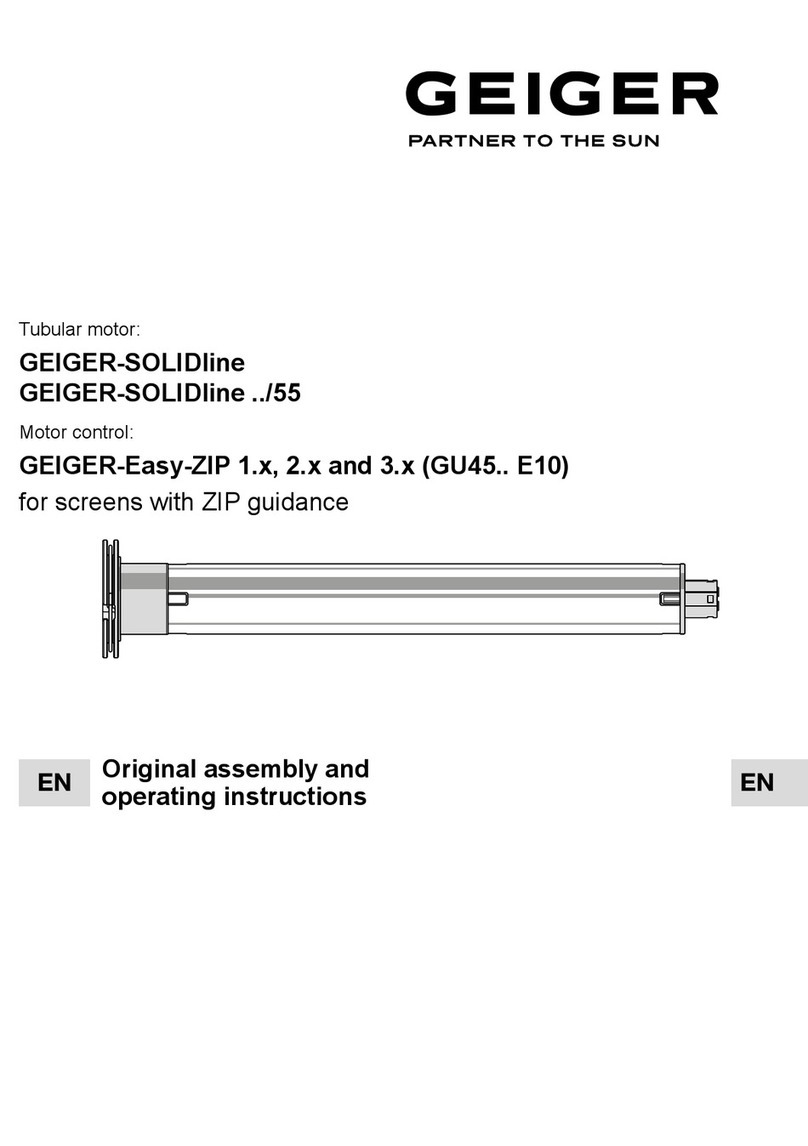
GEIGER
GEIGER GEIGER-SOLIDline Series Original assembly and operating instructions

EMAK
EMAK K605 owner's manual
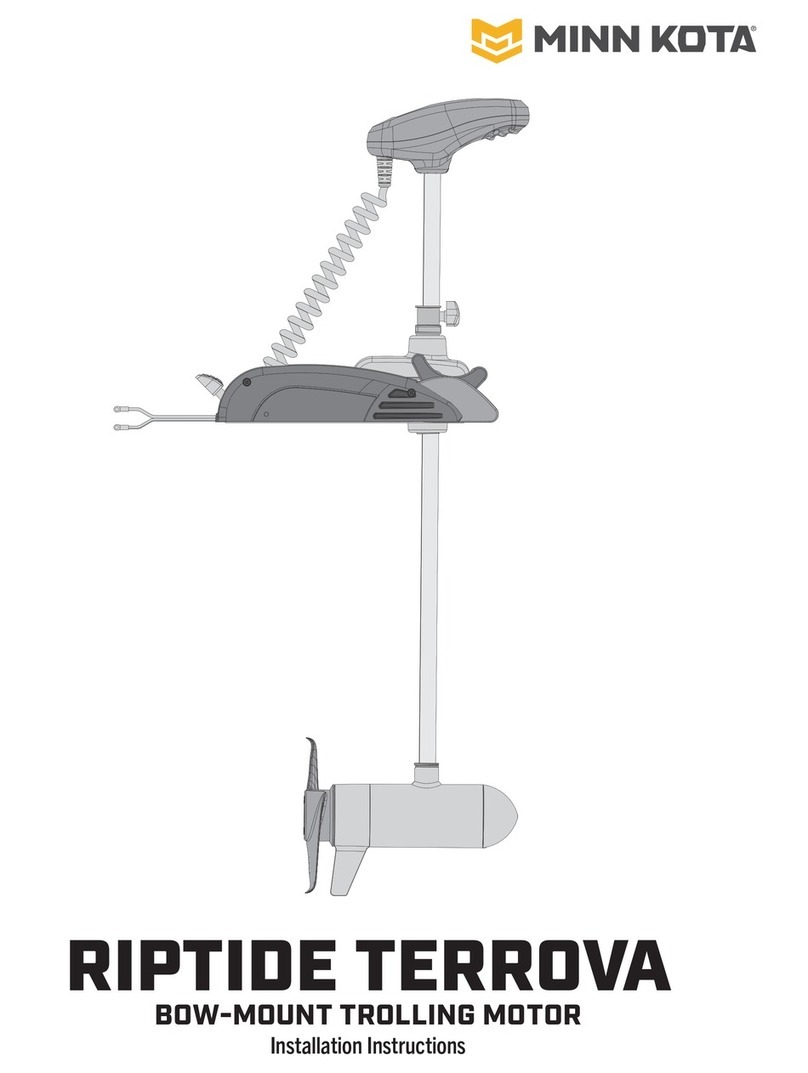
MINN KOTA
MINN KOTA RIPTIDE TERROVA installation instructions
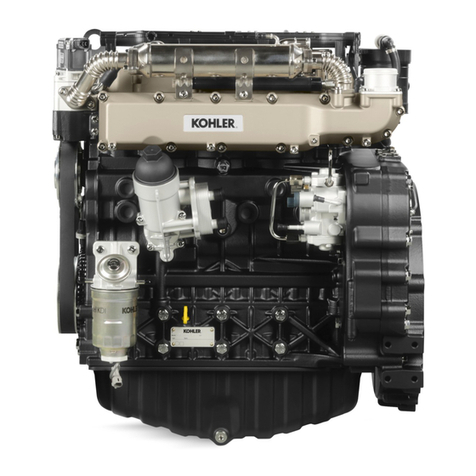
Kohler
Kohler KDI 3404TCR-SCR owner's manual
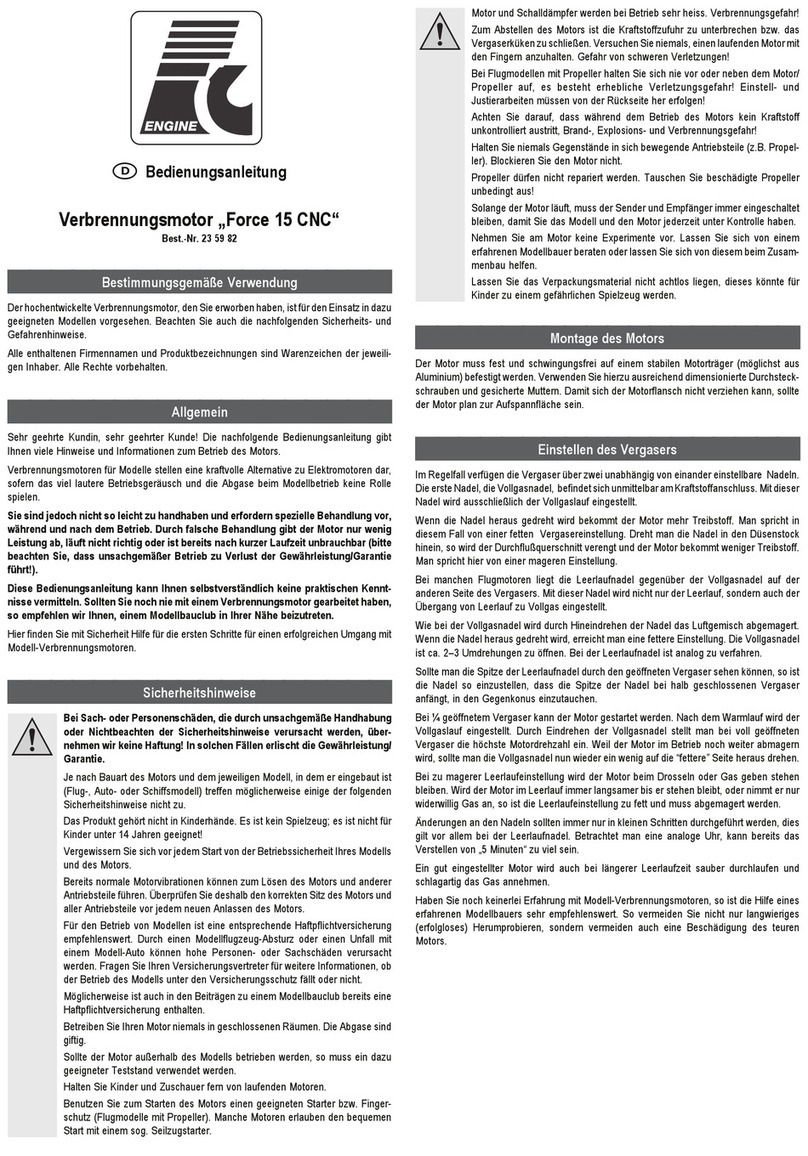
Force Engine
Force Engine Force 15 CNC operating instructions

Kohler
Kohler COMMAND CH18-745 Service manual

